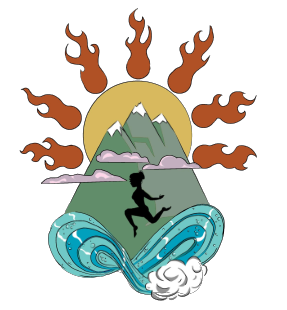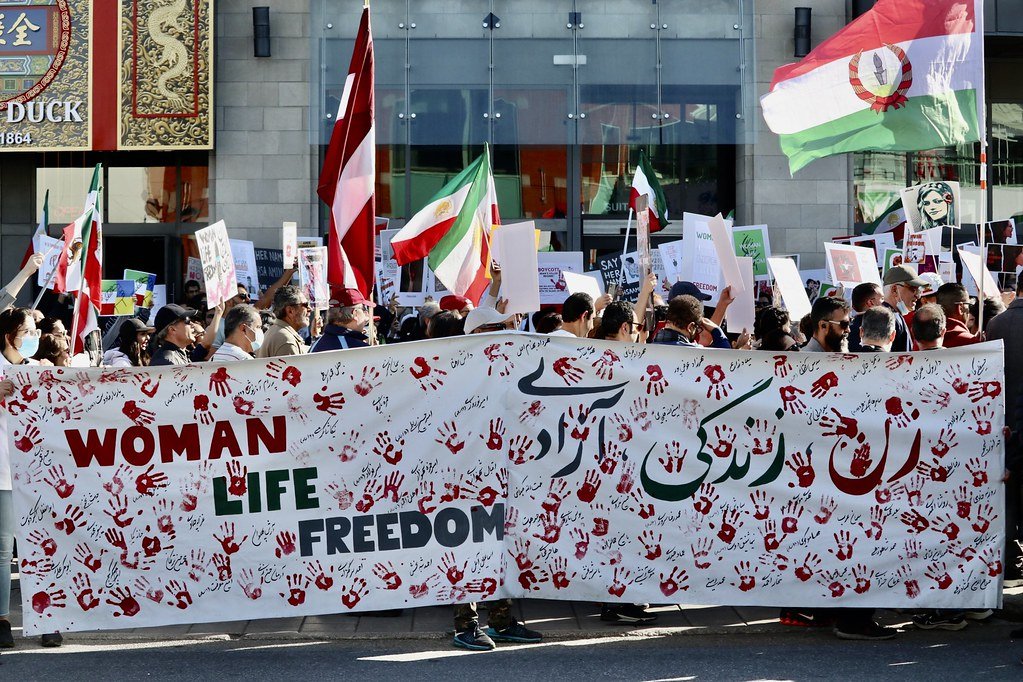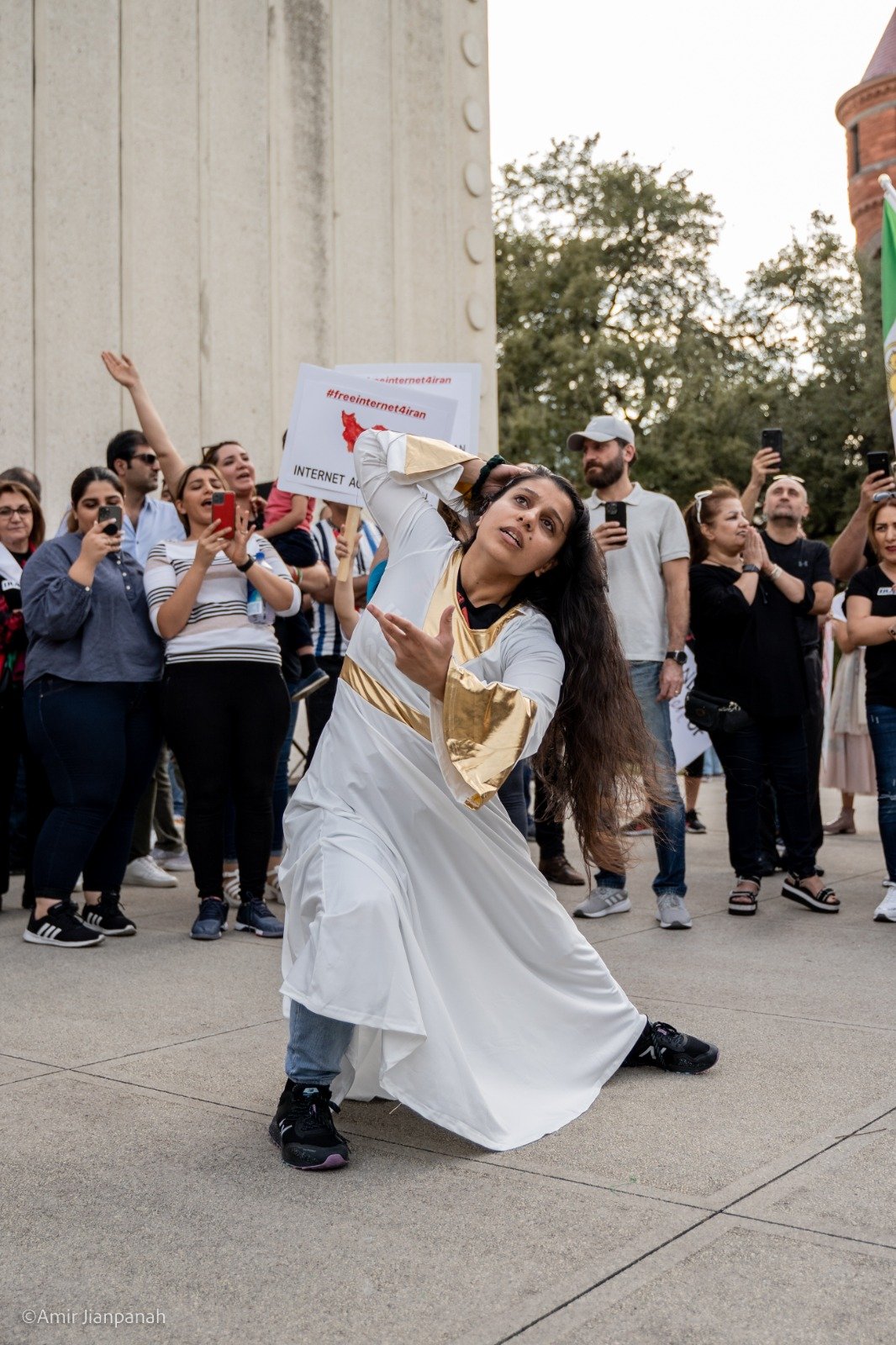Woman, Life, Freedom, and Dance; A Conversation with Iranian Artist Shahrzad Hamzeh
A few weeks ago, I sat down and spoke with Iranian dance artist Shahrzad Hamzeh. In a very vulnerable testimony, they unpack the personal and collective dimensions of the Woman Life Freedom movement.
Iran Protests by Taymaz Valley.
Woman, Life, Freedom– if you’re familiar with this phrase, then you’re somewhat up to date with the current revolution happening in Iran. If not, it’s never been more vital to catch up.
On September 16th 2022, a young woman named Mahsa Amini was beaten to death for improper hijab. After her unjust death, the Iranian people– most notably, young women–began protesting the brutal social injustices committed by the current regime. Since then, many more injustices have followed, including numerous deaths, an internet black-out, and widespread misinformation and propaganda.
While the unfolding events are briefly covered in the mainstream news, many key intricacies, realities, and experiences go under-discussed. Shahrzad Hamzeh, an Iranian immigrant, artist and choreographer living in the USA, graciously shared their personal experience and perspective with SIEDC. In our conversation, we unpacked what women’s indentities look like under the corrupt Islamic Regime, why it’s crucial to apply international pressure, and how dance is used as an act of resistance.
Women’s Identities under The Islamic Regime
In our collective mind, we can hold a certain image or impression of what a corrupt regime looks like, and more often than not, we think of the larger events that scale the news across the world. However, rarely do our images include many of the multifaceted, painful encounters of everyday life. In reality, corruption begins in person to person interactions, and it is consistent and slow.
Beginning with childhood, Shahrzad examined a key theme everyone experiences in life under the Islamic regime: lack of autonomy. In Iran, many people are very much in disagreement with the government, but have little say over their own children’s lives:
Shahrzad Hamzeh (They/Them) performing during protests. Courtesy of Amir Jianpanah.
I grew up where I could dance in my house, but I was told to be careful not to dance in front of strangers…My dad was like, ‘everybody has their own beliefs, I can’t force you to do anything.’ But then I would go to school, and I was forced to say prayers. When I was in highschool, I told my dad I wanted to shave my head and he shaved my head for me. I was called to the principal's office, and I was asked if I had lice. Something as simple as what to do with my hair, was still something that felt controversial. This feeling that you’re not who you’re supposed to be.”
Within their own home, Shahrzad felt safe to be themself, but as soon as they stepped outside there was a sense of immediate danger. Shahrzad explained how this can developmentally impact young women’s identities: “It’s gender apatheid, literally. I had to wear hijab as young as 6 years old, even though all the teachers are female. Even in Islam the laws start when you’re 9 years old… you’re not supposed to force a 6 year old to cover-up. You’re little and you don’t understand those concepts.”
For children as young as 6, it’s fundamentally damaging to be taught that your body is inherently sinful and inherently less than a male body. For women in Iran, these lessons about bodily autonomy are instilled as young as 6, and the severity and intensity of the lessons only escalate with age. Shahrzad opened up about how pervasive fear is:
“One of the things I remember is that they were constantly asking people to be a spy. Because they have instilled this fear in us, there’s fear that you could be reported by anyone… I was arrested twice… Even now I catch myself thinking, censoring myself because I’m still living with that fear. When I had just come to America, I was driving and I saw this police car, and my hands went unconsciously to my head.”
For women around the world, bodily autonomy is consistently platformed as a debatable topic. In plain words, though, one of the greatest battles for women’s bodily autonomy and rights is happening right now in Iran; and Shahrzad thinks that many do not understand how persistent, complex and dire the situation truly is:
'‘It’s so hard to explain. Even imagining that is hard for people. To tell them that people die because they aren’t wearing hijab the way the government defines it–which of course, was never clear. You could never tell the right way to wear the hijab. It depended on the police that were standing on the crossroads. Sometimes you felt like they didn’t like your face, they didn’t like the way you walk. When they shove you in that van, you see people that have different attires.”
Under this regime, officials and representatives like the morality police are allowed to wield their power however they see fit. Within the law itself, there is no one standard to wear the hijab, and what defines an improper hijab is subject to the government official. Women with entirely different attires are imprisoned, and there’s no real clear procedure on imprisonment itself. Reflecting on this, Shahrzad stated: “You feel like they’re marking us. We all have a uniform. We get killed if we are not wearing it right. What does that remind you of?”
Women’s rights in Iran have been under attack in multidimensional ways. Beyond unjust murders and imprisonment, Shahrzad states that there’s quite a lot of infrastructure in place to instill a gender apatheid:
“There are no rights. If my father would kill me, he wouldn’t go to prison. Because I’m his property. But there are women, or people in prison because they objected to the forced hijab. They’re gonna be there for 10 years or more. How does this work? As a woman if I were married in Iran, I could never ask for a divorce. I don’t have that right. If I want to go to school and my husband doesn’t want me to, legally I can’t go to school. Or work, leave the country or travel anywhere. I can’t leave the house if my husband doesn’t want me to. My husband could beat me to death, and nobody will object to that. What is this? How is this okay? How is the world okay watching this?
In Iran, having a boyfriend or girlfriend is illegal and can get you arrested, you might be stopped by the police and asked who the guy is that you are in a car with, or walking on a street with. You will be executed for being in the LGBTQIA+ community. If you practice any religion other than Islam, you will have difficulty going to school and university. Media, art, film, and all content are censored by the government. Playing music or dancing in public is punishable by law. Having a pet dog is illegal and if you have one it will be taken away from you, probably killed. On top of it all, if you speak up against your government you will be imprisoned, tortured, and even killed.”
Speaking Out: Battling Misinformation and Discomfort
For many in the West, speaking out about events in Iran can be portrayed as a taboo subject. Inside and outside Iran, there’s been much misinformation about the current events and how to speak on current events. For one, many mistake the criticism of the Woman Life Freedom movement as Islamaphobia, when in reality the current events have little to do with Islam, and more to do with a corrupt dictatorship. In India, women are suing to wear their hijabs. In both cases, the conversation is directly about agency and autonomy for women, not about religion itself.
In addition, because Iran has oil, many won’t speak on the subject. Shahrzad unraveled this strange dynamic:
“They feel wrong admitting something is wrong with this society. But if you don’t admit this is happening, you can never fix it. A lot of people, it just makes them uncomfortable. I don’t want to do that, because I don’t want to know there is an ugly face to the world. ‘The smell of the oil is louder than the smell of the blood spilling in the streets.’ Because we have oil, our lives don’t matter.”
How can you stand there and not make a statement? Why are people quiet? Like why aren’t you posting? You have almost 80 million followers, you post about caring about people in Africa. Why does it have to take so many messages to a person who says they care, and that they’re a feminist, and a human rights activist? Why should it take so many messages to make them post one picture to say that they stand with Iranian woman? Why do I have to tell you to do this? It should be automatic, women are dying for no good reason.”
What’s happening in Iran is blatant brutality, and the devastating reality of the situation is much darker than many realize. In a moment of deep sorrow, Shahrzad stated: “People do not have guns. It’s just their hands, they’re fighting with their life, with their body. Why do I have to ask you to stand with Iranian women?”
Shahrzad Hamzeh (They/Them) performing during protests. Courtesy of Amir Jianpanah.
Dance as Resistance; A Bold Act of Bravery
Despite everything, people are fighting. As the protests continue, the people of Iran are demonstrating feats of remarkable bravery rarely seen on the world stage. Thinking of the use of dance in the protests, I asked Shahrzad about a moment in the protests where a young woman took off her hijab, threw it into the fire, and began to twirl. Shahrzad answered by defining what that moment means in the context of the power dynamics in Iran:
“Dancing is another way of showing your resistance, because a woman’s body has always been a political tool. The whole ideology of the Islamic Republic is based on how to be a good woman. So to take my hijab, then dance–two things that I was told not to do–to dance and burn it–it's an act of resistance, an act of protest, an act of defiance.”
As a dancer and choreographer themself, Shahrzad had a unique perspective on what it means to reclaim agency and artistry as an Iranian woman:
“I’ve gotten better at using dance as a tool to show my objections, to show my disagreements. When I was back in Iran, I was dancing, I was teaching. I was so focused on how to get the dance done, that I couldn’t use it as a tool for protest. So to leave that situation has given me the opportunity to use dancing as a tool to reclaim my culture. When I came to America, I landed in the Midwest. I was somewhere where you could only see white people and cornfields. Nobody even knew what Persian dancing was. That pushed me to use dancing to showcase my culture, to show my objections. It helped me grow.
When I was in that situation, all I could think was ‘How can I dance? All I wanna do is dance.’ When I removed myself from a situation where I didn’t have to think about who’s watching me, who’s filming me, who am I telling that I dance, and I look at my dancing as something more like ‘Oh my god, I’m in America, I have the freedom to dance anywhere I want.’ So many times I have randomly started dancing in the middle of the street and people have looked at me weird. Because I can.
I have this thing that I am very good at, and I can use it as a way to talk. When you look at someone and you tell them: ‘dancing is illegal in Iran, we need to change that,’ People don’t listen to you. But when you dance, transform, and get that message across through your art, through dancing, through the performance, they start talking about it… For me, it has been amazing to remove myself from that situation. I feel guilty right now because I fled. But if I want to be honest, I don’t think I could’ve used my dancing the way I am using it now as a tool to show my objection to show that I am fighting, if I were there. There’s also controversy there. I feel guilty as hell for being here and not there, but I don't think I could have done what they are doing back there. Dancing is all I can do. My body is my weapon and my dancing is my fighting.”
Being Present for the Iranian People; What We Can Do
As global citizens, there’s certain actions we can take to help women in Iran. Shahrzad recommends the following actions:
Sign petitions against propaganda:
There are journalists, media figures and government officials spreading propaganda about the situation in Iran. There have been fake fundraisers that have gone viral. If you see something, report it; if you see a petition calling someone out, sign it.
Contact your Government Leaders about the Islamic Republic:
Contact your government leaders and request that they don’t recognize the Isalmic Regime as the Iranian Government. The current Islamic Regime doesn’t represent the people, so it’s important to request that global governments don’t treat it as a legitimate government. If other countries have embassies and government figures inside Iran, Iranians want them to be called back home.
Keep posting with relevant hashtags:
In the wake of the internet blackout, posting with hashtags (#mahsaamini #womenlifefreedom) is essential to organization and information.
Be there for your Iranian friends:
Many Iranians have families still in Iran, and are experiencing excruciating stress. If you have the capacity, lend an ear and a hand.
For many Iranians both at home and abroad, speaking about the events is not easy, safe, or without consequences. Speaking out is an uncomfortable and traumatic action of bravery many have to take. When Iranians speak about their experience, know that it is coming from a place of tremendous pain. Most importantly, Iranians are also jeopardizing their identities, their safety and their security to even speak to you about the current events in Iran.
As citizens of the world, it is important to approach the situation not only with the utmost empathy, but the utmost respect and severity. Young women are dying, and as Shahrzad states, a collective response in defense of them should be automatic. No matter where we are in the world, we are stronger together.
SHAHRZAD HAMZEH
Shahrzad Hamzeh is an Iranian Researcher, Dancer, Choreographer, Model, Actress, Producer, Director, Dramaturge, Poet, Writer, Photographer, and Artist who left their home country to pursue their passion for dance due to the illegality of dance in Iran. They first started dancing when they were five years old with their sister’s guidance. They later continued to self-train through instructional CDs and movies. All through elementary to high school, they took classes on aerobics and rhythmic movements at the local gyms, and they were trained to be a Zumba instructor by the time they were 20 years old.
Their love of dance lead them to Arezou Zare’ who taught them the intricacies of Bollywood and some amateur Russian dancing. While they were getting their BA in Urdu Language & Literature at the University of Tehran they studied Kurdish dancing with Vria Boojar and Asu Naderi which led to their appearance in Aziz-E Shahngal directed by Qodbeddin Sadeghi. At the same time, they trained in Classical and Modern Persian dances, Azeri, Turkish and Spanish Belly Dancing, and Sevianna with Mina Moradi who tutored Hamzeh for about four years. Though they loved learning about movements and how to execute them, they felt the need to know more about the history of what they were being taught. That is why they decided they need to leave their country and family behind to be able to research dance. This decision led to their graduation with a MA in Theatre Studies from Illinois State University. While a student at Illinois State University they presented papers on dance and performance in Iran, and taught amfew classes on Persian dances, Belly dancing, Kurdish, and Azeri, lectures and movement.
They are now a PhD student at The University of Texas at Dallas majoring in Visual and Performance studies with a focus on dance. They are hoping to add Persian dance and other Iranian performances to the dance curriculum. They want to make their passion, something that they had so much difficulty learning about, more accessible to everyone who desires to learn about it. Their research interests are dance and religion, dance and sexuality, dances of SilkRoad, ritualistic dance, and healing by dance.





